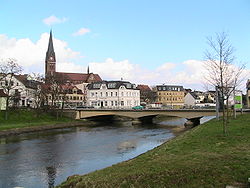Stassfurt
| Staßfurt | ||
|---|---|---|

View of the town
|
||
|
||
| Coordinates: 51°52′N 11°34′E / 51.867°N 11.567°ECoordinates: 51°52′N 11°34′E / 51.867°N 11.567°E | ||
| Country | Germany | |
| State | Saxony-Anhalt | |
| District | Salzlandkreis | |
| Government | ||
| • Mayor | René Zok (Ind.) | |
| Area | ||
| • Total | 146.53 km2 (56.58 sq mi) | |
| Population (2015-12-31) | ||
| • Total | 26,634 | |
| • Density | 180/km2 (470/sq mi) | |
| Time zone | CET/CEST (UTC+1/+2) | |
| Postal codes | 39418 | |
| Dialling codes | 03925 | |
| Vehicle registration | SLK, ASL, BBG, SBK, SFT | |
Staßfurt (Stassfurt) (German pronunciation: [ˈʃtasfʊʁt]) is a town in the Salzlandkreis district, in Saxony-Anhalt, Germany. It is situated on both sides of the river Bode, approximately 15 km (9.3 mi) northeast of Aschersleben, and 30 km (19 mi) south of Magdeburg. Pop. (2005) 23,538.
It was one of the chief seats of the German salt-producing industry. It is still surrounded in part by the ruins of its ancient walls, but, with the exception of the parish church of St. John (15th century), there are no buildings worthy of special notice.
Although saline springs are mentioned here as early as the 13th century, the first attempt to bore for salt was not made until 1839, while the systematic exploitation of the salt-beds, to which the town is indebted for its prosperity, dates only from 1856. The shafts reached deposits of salt at a depth of 850 ft. (190 m); but the finer and purer layers lie more than 100 ft. (31 m) below the surface. The rock-salt is excavated by blasting. Besides the rock-salt, the deposits of Stassfurt yield a considerable quantity of deliquescent salts and other saline products, which have encouraged the foundation of numerous chemical factories in the town and in the neighboring village of Leopoldshall (currently part of Staßfurt). The rock-salt works are mainly government property, while the chemical factories are in private hands. The town is also home to Staßfurt Museum shed, which houses many preserved steam locomotives.
The Stassfurt potash deposit, a part of the same evaporite sequence that hosts the salt mines, is notable historically as the site of the earliest large-scale mining of potash for fertilizer, beginning in 1861.
Halite crystal from Stassfurt Potash deposit. The beautiful azure-blue color banding is sought after by mineral collectors.
![]() This article incorporates text from a publication now in the public domain: Chisholm, Hugh, ed. (1911). "". Encyclopædia Britannica (11th ed.). Cambridge University Press.
This article incorporates text from a publication now in the public domain: Chisholm, Hugh, ed. (1911). "". Encyclopædia Britannica (11th ed.). Cambridge University Press.
...
Wikipedia



